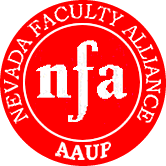In the winter issue of The Alliance, we report on the most important development in Nevada higher education news this fall: the Interim Committee on the Funding of Higher Education. This is good news, especially for students, who have faced significant increases in fees and tuition due to reductions in state investment in NSHE. These students have a right to know that the money they pay stays on campus and is not funneled indirectly back to the General Fund or to another campus through a flawed formula that holds back state support as tuition revenue increases.
Beyond fairness to students, what does this mean for faculty?
First and foremost, we should support this effort. It is our best chance for the state to consider seriously how it can address the education deficit. Just as Nevada trails the nation in economic recovery, we lag behind in the proportion of our population that attends, and graduates from, institutions of higher education. We all know that the Nevada System of Higher Education cannot hope to improve on that score without a serious conversation about how to better allocate scarce resources. Because the challenge is so great, faculty ought to support a thoroughly new approach to higher education funding, not just a revision of a formula that has been in place, with only modest changes, since the 1980s.
We also ought to support a formula that better reflects the real cost and the real diversity of the work we do. The existing formulas are both too imprecise in their calculations of cost and too rigid in how they fund instruction. In current form, the formulas are supposed to allocate resources to match the type of instruction and the cost of the program. However, they are not based upon the actual cost of instruction of any program (in terms of either capital expenses or the actual market cost of hiring faculty in that discipline). Nor do they make any allowance for what we might call the "value added through instruction" -- that is, what students learn. So the formula ought to address the actual cost of instruction and the value added; because this will vary from campus to campus, introducing those factors will help support our differentiated missions. Our System is much too large – and more importantly our faculty is much too diverse in its training, its job responsibilities, and its performance – for a one-size-fits-all formula.
Although faculty-to-student ratio is a part of the current formula on paper, no campus currently actually targets its faculty size to the faculty-to-student ratio for which it is funded. This results in a negative incentive for a campus to under-staff and over-enroll programs designated as “high cost” – and more generally to achieve the highest enrollment with the fewest and cheapest faculty. That incentive to overburden faculty is no formula for student success, and the new formula must correct this.
Moreover, there is at present no component of the current formula for faculty work other than instruction, meaning the costs of a research infrastructure that supports economic development and technology transfer is not reflected. The lack of a research component to the formula burdens all faculty at all levels, and worse, it holds back Nevada’s economic recovery.
Finally, the Chancellor has made it clear that Nevada will move at least some of its formula to performance-based allocations, which reward campuses that produce more graduates. Faculty ought to support that goal, since graduating students is our vocation as well as our mandate.
But we ought to be cautious about performance-based allocation based not on total number of graduates but metrics that are believed to correlate with graduation rate. Such "progress measures" have not been studied sufficiently, in Nevada or nationally, for us to know which variables contribute most directly to degree completion. We need to study the data to know, for instance, if the ratio of students who complete their first year courses or who enroll on a full-time basis, actually correlates, on NSHE campuses, to more graduates.
Until we can study what the data concerning retention, first-year course completion and other progress measures actually tell us about how we help students succeed, faculty will rightly be wary of a performance-based formula with too many progress measures. Unintentionally, it could create administrative pressure to inflate grades and otherwise “water down the drinks,” in terms of student outcomes, in order to raise retention rates.
That said, NSHE faculty ought to embrace and support a data-driven overhaul of our funding formula that makes student success, rather than just enrollment, our priority.
Wednesday, November 23, 2011
Subscribe to:
Post Comments (Atom)






This comment has been removed by a blog administrator.
ReplyDeleteThis is really a inspirational and inspirational writing i really liked it.
ReplyDeleteDegree Completion
What happens to campaign funds when a candidate loses an election? I've heard that they get to keep some of the money. Is this true?
ReplyDeletephlebotomy training nevada